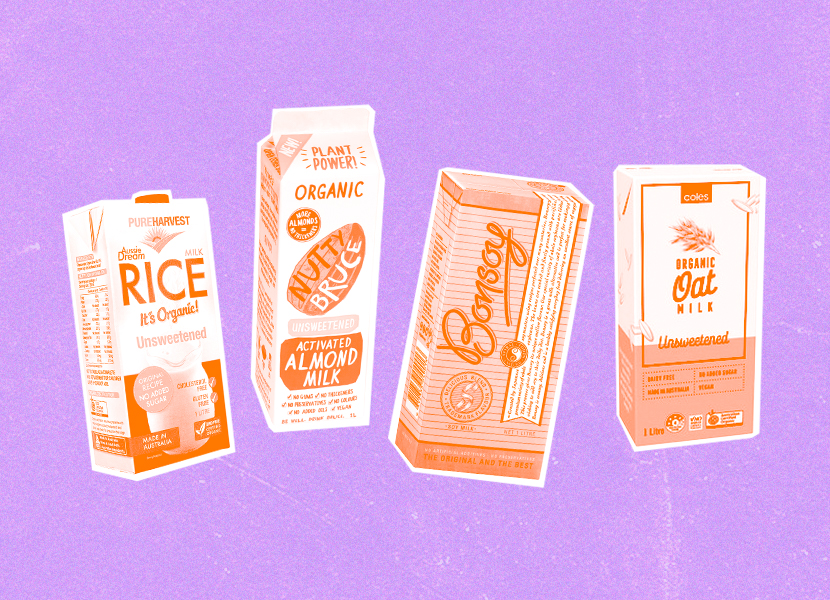We tested milk alternatives so you don’t have to
Words by Hannah Cole
No dairy? No worries.
Ten years ago, soy drinkers were few and far between. Oh, how the world has changed. Animal products are increasingly out of vogue and with new studies and doomsday reports released frequently, cows are copping it big time for their methane emissions. The answer? Milk alternatives.
As we turn to the myriad of plant-based options now before us, it’s easy to feel a sense of decision fatigue. “There are too many options,” I think, as my eyes glaze over in confusion. It’s scary (and often expensive) to branch into this upside-down world. No one wants a morning coffee ruined by a daring – yet possibly disappointing – milk choice.
So, I’ve done the hard work for you. Whether you are looking to lower your carbon footprint, go vegan or keep up with the trends, here’s my breakdown of the top alt-milks.
[NB: I am not a nutritionist, just a good researcher].
Soy Milk
Thanks to my soy-snob friends, I knew Bonsoy was the only credible option to analyse. Health-wise, Bonsoy is high in protein, with added calcium and no bullshit additives. However, the overarching debate of soy’s impact on fertility and thyroid issues still plagues my mind. Soy is also notorious for genetic modification in much of the world, eradicating biodiversity and causing environmental harm. This is *thankfully* banned in Australia. While Bonsoy doesn’t support GM crops, we also need to consider the distance your tasty soy has travelled to reach your coffee. The food miles add up quickly when it’s made in Japan.
To add a rounded opinion to this test, I enlisted the taste buds of my partner as well – a sceptic at the best of times. To an avid dairy drinker, soy tastes decidedly “funny” or “off”, even to an alt-drinker, the taste oddly similar to my boiling chickpea water.
Flavour = Most definitely acquired.
Environmental and health status = Questionable.
Almond Milk
Bombshell: almond milk is rife with bad news. It takes 5 litres of water to grow one single almond (!!). Adding to this, most almond crops are grown in drought-affected areas of the world – namely, California. We’re sucking the planet dry with our almond obsession. While almonds naturally contain vitamins, almond milk is notorious for additives – sugars, thickeners, emulsifiers – and frequently include less than 2% actual almonds. If a vegan, eco-friendly diet is supposed to be supporting the planet, fake additives don’t sound too good.
Nutty Bruce (Unsweetened) is my almond milk of choice for home (and contains 7% almonds). The base may be watery, but there’s a particular taste that complements my overnight oats perfectly. Although the flavour didn’t win over the sceptic: “It goes down easy.”
Flavour = We can work with it.
Environmental and health status = DIY is best for the planet and your health.
Rice Milk
Rice milk is the least allergenic and easy to stomach, but also high GI and low in protein (not ideal for the elderly or youngsters). As with almonds, rice is thirsty. Add to this the distance travelled to get to our doors, and I’d leave it in the “only if you must” category.
My opinion didn’t change post-taste. Although the organic Pure Harvest Rice Milk claims no extras added, it was sickly sweet with a chalky aftertaste. If you pushed us, we would drink it with Milo. Basically, disguise it as something entirely different.
Flavour = No thank you.
Environmental and health status = Only bother if the dietitian makes you.
Oat Milk
Oat milk flipped the alt-milk conversation in 2018. Oatly, an incredibly trendy Swedish offering, dominated the US market and has finally landed on Australian shores. In Oatly’s 25-year existence, sustainability has sat at the core. They work with local Swedish farmers to supply by-product kernel hulls to farms to be used as feed, avoiding landfill. (What we need now is an equivalent company to work with our local crops and farms). Oat milk reportedly has more protein and fibre than almond milk, is creamier (making it a barista favourite) and cheaper. Most brands fortify the milk with calcium for extra health benefits.
Alas, there is no Australian equivalent that works sustainably with local crops and farms. And Oatly itself is not easy for the everyday consumer to procure, so Coles home-brand it is. It won. The milk is sweet but not overbearingly so, with no bad aftertaste and could easily complement the usual milk suspects, be it coffee or cereal.
Flavour = We have a winner.
Environmental and health status = Look for locally sourced, fortified milks to add cred.
When it comes to milk alternatives, there’s no one-size-fits-all answer. But you know what to do: weigh up the options and make the call that suits you (and your ethics) best. Any reduction in meat or dairy-based products is a positive move for the planet.
Now excuse me while I contemplate my own oat farm.
[Editor’s Note: Since this article was published, Oatly is now available at Woolworths and across Australia.]










